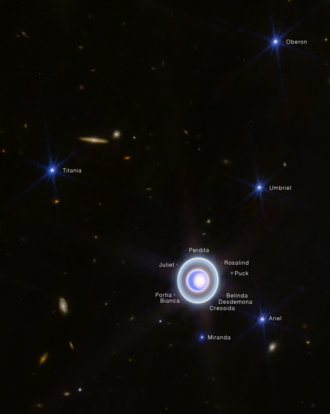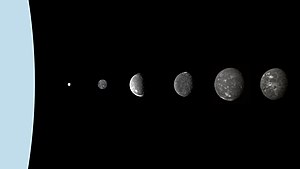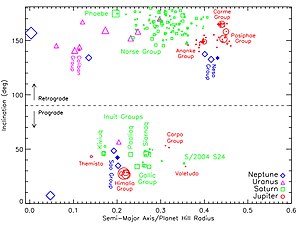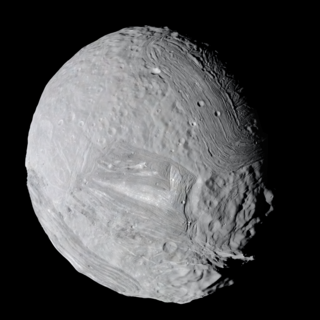
Miranda, also designated Uranus V, is the smallest and innermost of Uranus's five round satellites. It was discovered by Gerard Kuiper on 16 February 1948 at McDonald Observatory in Texas, and named after Miranda from William Shakespeare's play The Tempest. Like the other large moons of Uranus, Miranda orbits close to its planet's equatorial plane. Because Uranus orbits the Sun on its side, Miranda's orbit is nearly perpendicular to the ecliptic and shares Uranus's extreme seasonal cycle.

Umbriel is a moon of Uranus discovered on October 24, 1851, by William Lassell. It was discovered at the same time as Ariel and named after a character in Alexander Pope's 1712 poem The Rape of the Lock. Umbriel consists mainly of ice with a substantial fraction of rock, and may be differentiated into a rocky core and an icy mantle. The surface is the darkest among Uranian moons, and appears to have been shaped primarily by impacts. However, the presence of canyons suggests early endogenic processes, and the moon may have undergone an early endogenically driven resurfacing event that obliterated its older surface.

Uranus is the seventh planet from the Sun. It is a gaseous cyan-coloured ice giant. Most of the planet is made of water, ammonia, and methane in a supercritical phase of matter, which in astronomy is called 'ice' or volatiles. The planet's atmosphere has a complex layered cloud structure and has the lowest minimum temperature of 49 K out of all the Solar System's planets. It has a marked axial tilt of 82.23° with a retrograde rotation period of 17 hours and 14 minutes. This means that in an 84-Earth-year orbital period around the Sun, its poles get around 42 years of continuous sunlight, followed by 42 years of continuous darkness.
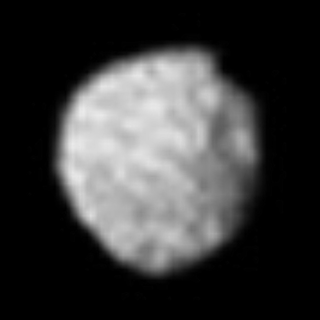
Puck is an inner moon of Uranus. It was discovered in December 1985 by the Voyager 2 spacecraft. The name Puck follows the convention of naming Uranus's moons after characters from Shakespeare. The orbit of Puck lies between the rings of Uranus and the first of Uranus's large moons, Miranda. Puck is approximately spherical in shape and has diameter of about 162 km. It has a dark, heavily cratered surface, which shows spectral signs of water ice.

Oberon, also designated Uranus IV, is the outermost major moon of the planet Uranus. It is the second-largest, with a surface area that is comparable to the area of Australia, and second most massive of the Uranian moons, and the tenth most massive moon in the Solar System. Discovered by William Herschel in 1787, Oberon is named after the mythical king of the fairies who appears as a character in Shakespeare's A Midsummer Night's Dream. Its orbit lies partially outside Uranus's magnetosphere.

Cordelia is the innermost known moon of Uranus. It was discovered from the images taken by Voyager 2 on January 20, 1986, and was given the temporary designation S/1986 U 7. It was not detected again until the Hubble Space Telescope observed it in 1997. Cordelia takes its name from the youngest daughter of Lear in William Shakespeare's King Lear. It is also designated Uranus VI.

Ophelia is a moon of Uranus. It was discovered from the images taken by Voyager 2 on January 20, 1986, and was given the temporary designation S/1986 U 8. It was not seen again until the Hubble Space Telescope recovered it in 2003. Ophelia was named after the daughter of Polonius, Ophelia, in William Shakespeare's play Hamlet. It is also designated Uranus VII.

Bianca is an inner satellite of Uranus. It was discovered from the images taken by Voyager 2 on January 23, 1986, and was given the temporary designation S/1986 U 9. It was named after the sister of Katherine in Shakespeare's play The Taming of the Shrew. It is also designated Uranus VIII.

Cressida is an inner satellite of Uranus. It was discovered from the images taken by Voyager 2 on 9 January 1986, and was given the temporary designation S/1986 U 3. It was named after Cressida, the Trojan daughter of Calchas, a tragic heroine who appears in William Shakespeare's play Troilus and Cressida. It is also designated Uranus IX.

Desdemona is an inner satellite of Uranus. It was discovered from the images taken by Voyager 2 on 13 January 1986, and was given the temporary designation S/1986 U 6. Desdemona is named after the wife of Othello in William Shakespeare's play Othello. It is also designated Uranus X.

Juliet is an inner satellite of Uranus. It was discovered from the images taken by Voyager 2 on 3 January 1986, and was given the temporary designation S/1986 U 2. It is named after the heroine of William Shakespeare's play Romeo and Juliet. It is also designated Uranus XI.
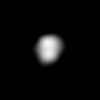
Belinda is an inner satellite of the planet Uranus. Belinda was discovered from the images taken by Voyager 2 on 13 January 1986 and was given the temporary designation S/1986 U 5. It is named after the heroine of Alexander Pope's The Rape of the Lock. It is also designated Uranus XIV.

Caliban is the second-largest retrograde irregular satellite of Uranus. It was discovered on 6 September 1997 by Brett J. Gladman, Philip D. Nicholson, Joseph A. Burns, and John J. Kavelaars using the 200-inch Hale telescope together with Sycorax and given the temporary designation S/1997 U 1.

Titania, also designated Uranus III, is the largest of the moons of Uranus and the eighth largest moon in the Solar System at a diameter of 1,578 kilometres (981 mi), with a surface area comparable to that of Australia. Discovered by William Herschel in 1787, it is named after the queen of the fairies in Shakespeare's A Midsummer Night's Dream. Its orbit lies inside Uranus' magnetosphere.

Ariel is the fourth-largest moon of Uranus. Ariel orbits and rotates in the equatorial plane of Uranus, which is almost perpendicular to the orbit of Uranus and so has an extreme seasonal cycle.

Portia is an inner satellite of Uranus. It was discovered from the images taken by Voyager 2 on 3 January 1986, and was given the temporary designation S/1986 U 1. The moon is named after Portia, the heroine of William Shakespeare's play The Merchant of Venice. It is also designated Uranus XII.

Cupid is an inner satellite of Uranus. It was discovered by Mark R. Showalter and Jack J. Lissauer in 2003 using the Hubble Space Telescope. It was named after a character in William Shakespeare's play Timon of Athens.

The planet Neptune has 16 known moons, which are named for minor water deities and a water creature in Greek mythology. By far the largest of them is Triton, discovered by William Lassell on October 10, 1846, 17 days after the discovery of Neptune itself. Over a century passed before the discovery of the second natural satellite, Nereid, in 1949, and another 40 years passed before Proteus, Neptune's second-largest moon, was discovered in 1989.
The naming of moons has been the responsibility of the International Astronomical Union's committee for Planetary System Nomenclature since 1973. That committee is known today as the Working Group for Planetary System Nomenclature (WGPSN).

The rings of Uranus are intermediate in complexity between the more extensive set around Saturn and the simpler systems around Jupiter and Neptune. The rings of Uranus were discovered on March 10, 1977, by James L. Elliot, Edward W. Dunham, and Jessica Mink. William Herschel had also reported observing rings in 1789; modern astronomers are divided on whether he could have seen them, as they are very dark and faint.
